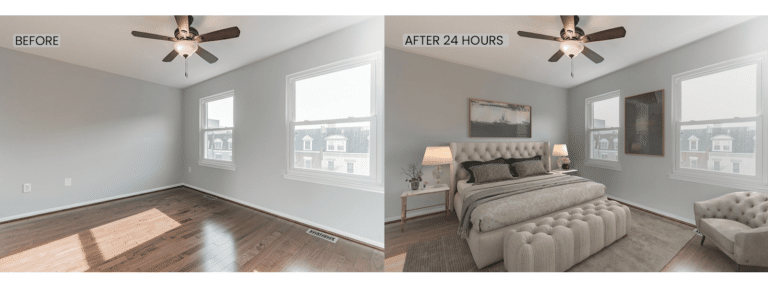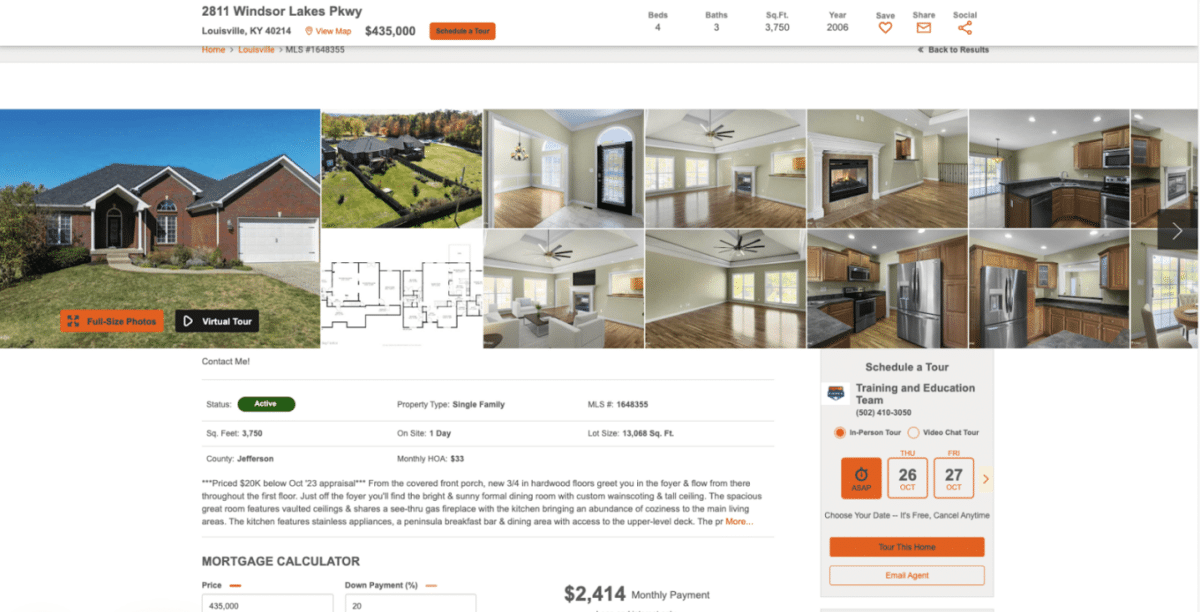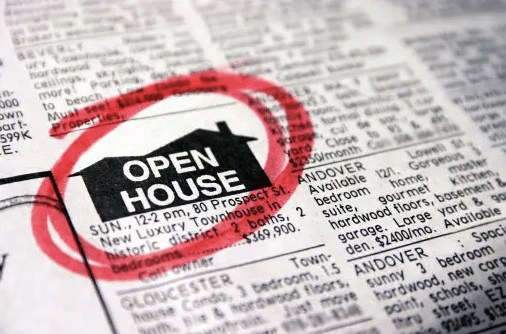10 Real Estate Agent Bio Examples & How to Craft Your Own
Your real estate agent bio is often the first thing a client reads — and can be the deciding factor in whether they reach out.
According to NAR’s 2025 Home Buyers and Sellers Generational Trends Report, buyers say experience is the most important factor when choosing an agent, followed closely by honesty and trustworthiness. That means your bio needs to do more than list your credentials. It should tell a story, showcase your local knowledge, and help clients feel like you’re the right fit for them.
Below, you’ll find real estate agent bio examples that work, along with a breakdown of what makes each one effective. Afterward, we’ll walk you through exactly how to write a bio of your own, with expert tips, templates, and short-form snippets you can copy and paste.
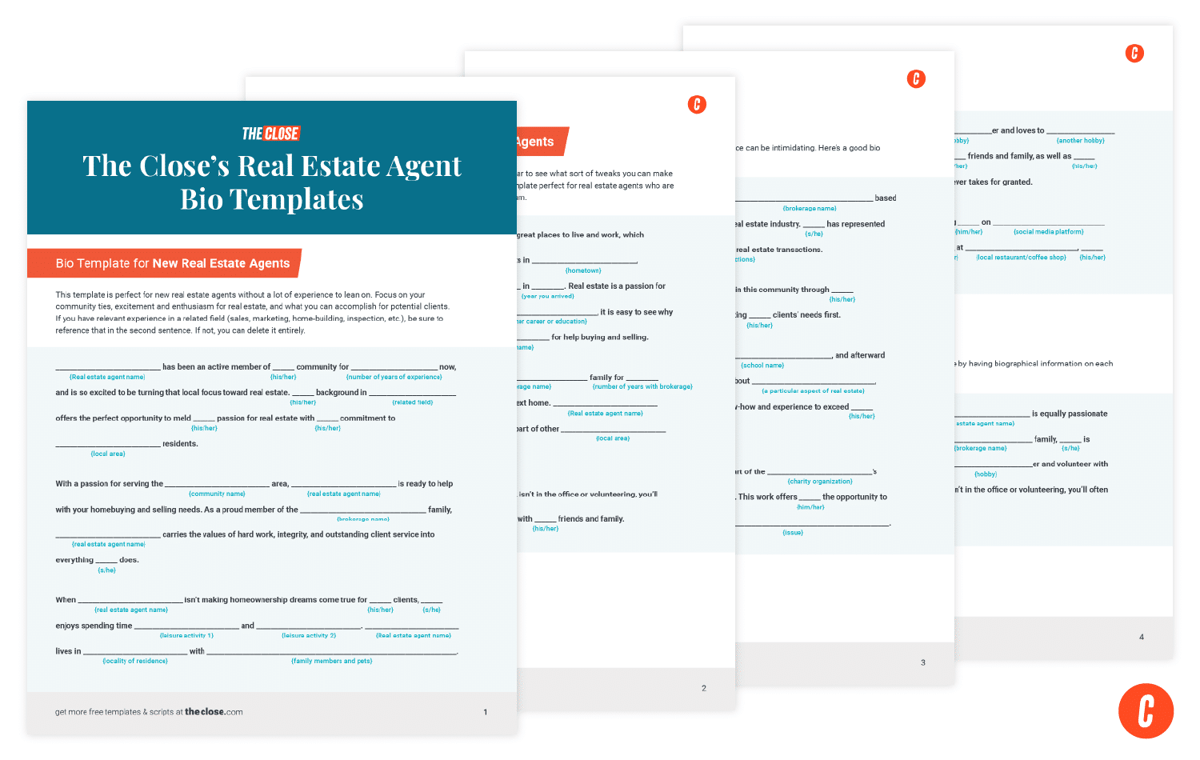
Download Our Real Estate Agent Bio Templates
1. Chris Adlam

Why it works: Chris opens his bio with a standout credential, then transitions into client-centered messaging. He emphasizes personal service, discretion, and long-term client relationships, making his bio feel both elite and approachable.
2. Ben Caballero
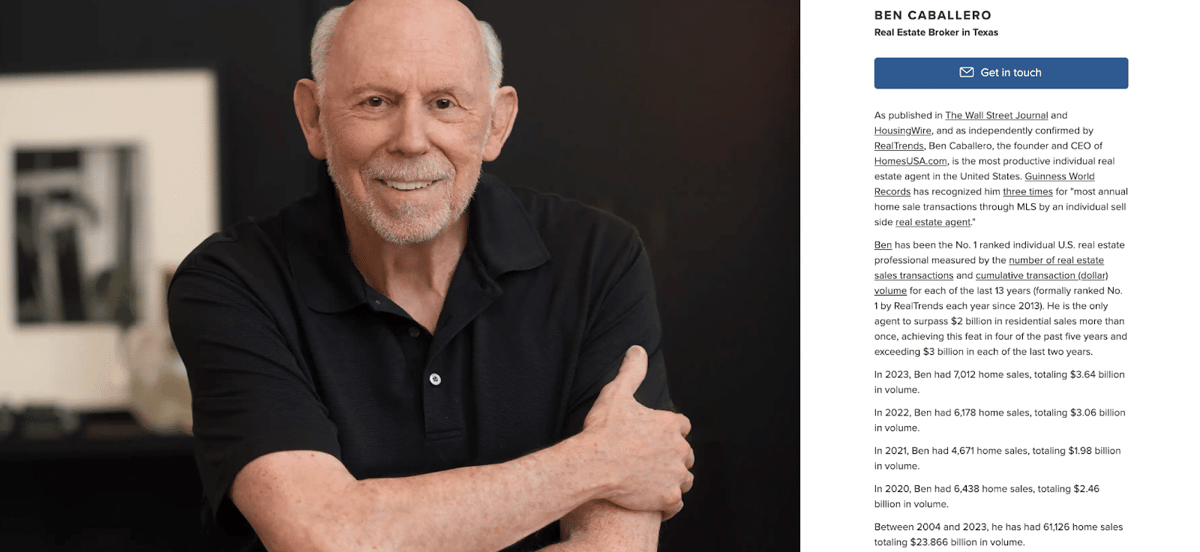
Why it works: Ben’s bio instantly positions him as an authority, highlighting multiple Guinness World Records, consistent top rankings, and billions in closed sales. He also links to press coverage for added credibility. It’s not just a list of awards, it’s a resume that speaks for itself!
3. Ginger Glass
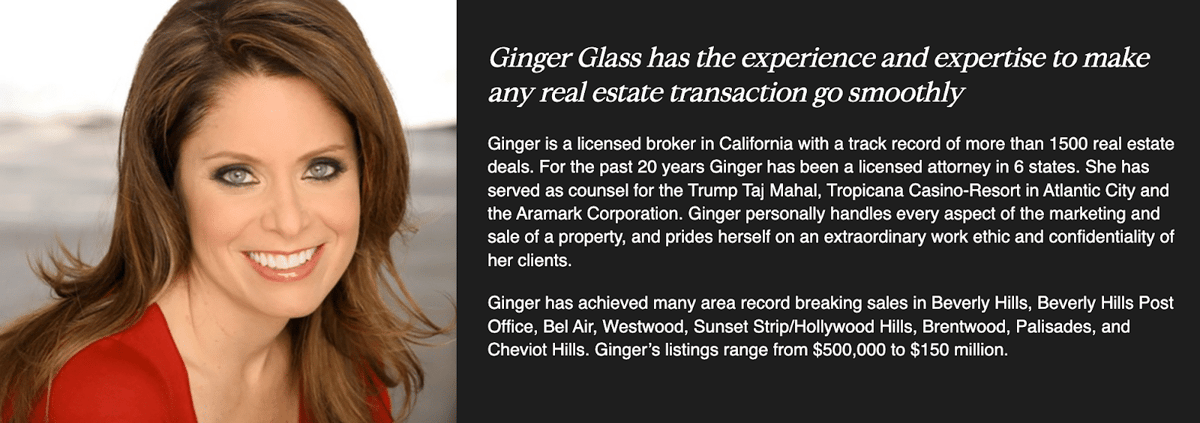
Why it works: Ginger’s bio is concise but high-impact. It clearly states her dual expertise as both a real estate agent and licensed attorney, setting her apart in a high-stakes market. This dual background builds instant trust with buyers and sellers seeking sharp negotiation skills and legal insight.
4. Alexa Lambert

Why it works: Alexa’s bio highlights her experience with high-profile clients, from Fortune 500 execs to celebrities. She names specific NYC neighborhoods and leverages her #1 broker rankings to build authority. It’s short, confident, and perfectly tailored to the ultra-high-end market.
5. John Scalia
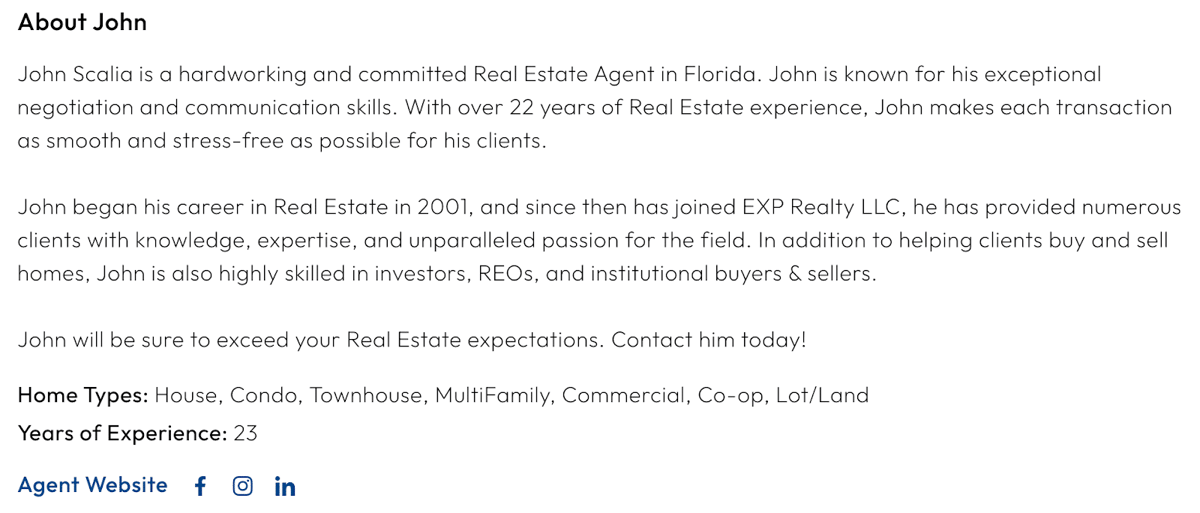
Why it works: John uses SEO keywords like “real estate agent in Florida” right in his bio — smart for visibility on search engines. I also like how he mentioned his other expertise besides helping agents buy and sell homes.
6. Tracy Campion
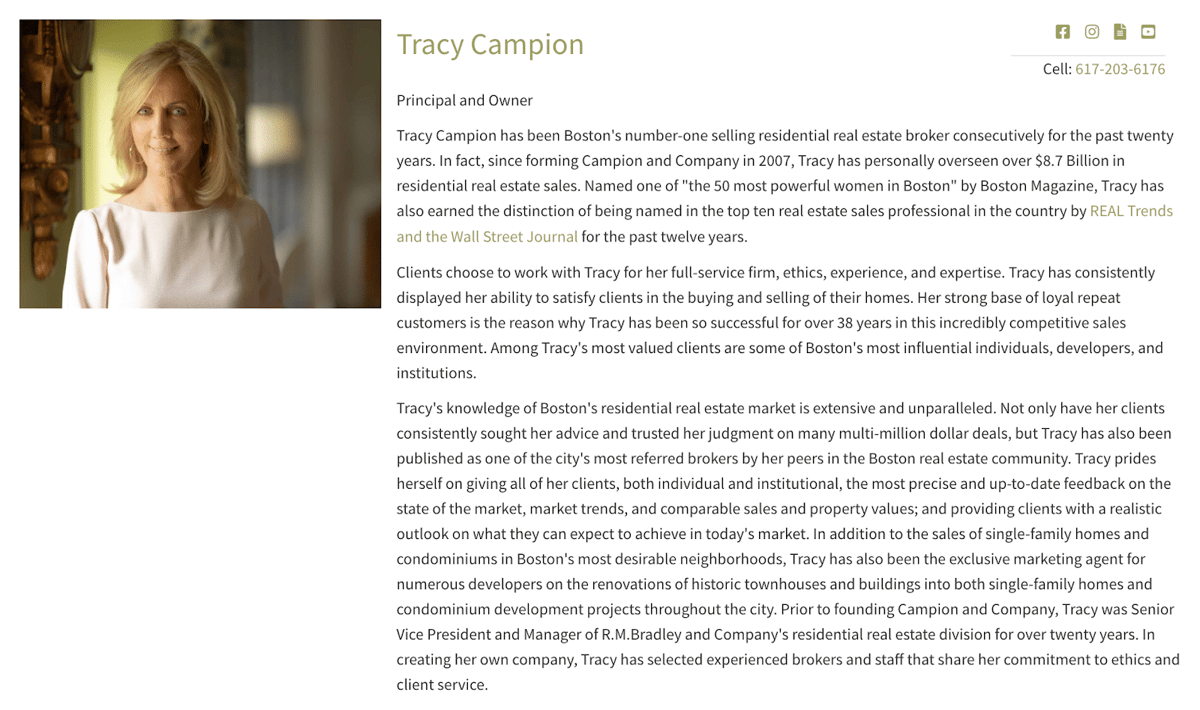
Why it works: Tracy Campion’s long-form bio highlights all her achievements in Boston, adding all her awards and distinctions with external links from trusted sites. I love that she mentioned her loyal repeat customers, which is a beautiful way of saying that her clients consistently have positive experiences. That, my dear reader, is how you create an image of reliability that appeals to potential clients.
7. Melissa Dailey

Why it works: Melissa Dailey’s realtor bio is effective because she enumerates her achievements and personal values with relevant buzzwords like “unwavering honesty and integrity.” While she calls herself a “top-producing” and “highly sought-after” agent, Melissa makes herself relatable by adding her hobbies, community involvement, and the schools she supports.
8. Jacob Mann

Why it works: In my opinion, Jacob Mann has a killer intro right here. He opens his bio with something personal and then enumerates his most significant achievements and how he started over 20 years ago. His deep ties to Greenville build his credibility as a trusted part of the community. My favorite part of his bio is how he ended it with, “He is the ‘Mann’ you need!” — which also makes a good tagline.
9. Kerri Pearce
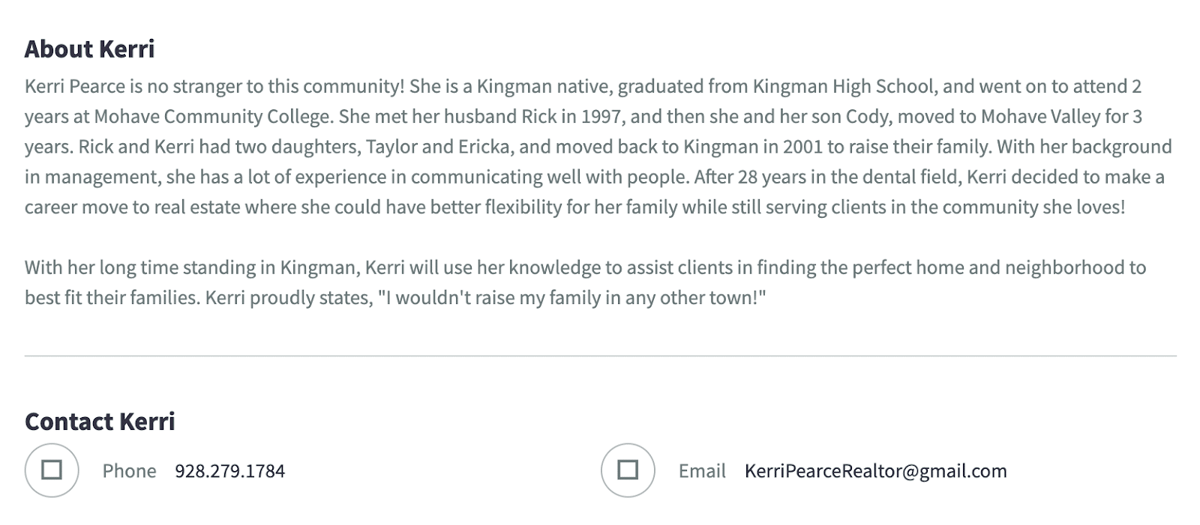
Why it works: Many agents switch to real estate after careers in other industries and then hesitate to include that experience. In Kerri Pearce’s case, she focused on her deep community roots, family life, and local expertise before mentioning her career move to real estate. If you’re a new agent without much experience in real estate, this is something you can do in your realtor bio.
10. Aaron Fowler

Why it works: Aaron’s bio is ideal for agents who don’t yet have years of experience but want to build confidence with clients. He focuses on his commitment to making the process as smooth as possible. If you want a similar bio, mention your dedication to providing a high level of service and interest in every aspect of the real estate process to reassure clients that you can handle complex transactions.
The Close’s real estate agent bio generator
Looking to save some time to create your bio? If you want more realtor bio examples for a new agent, try out our exclusive bio generator:
The Close Exclusive Real Estate Agent Bio Generator
Fill in some important details below. Our Real Estate Agent Bio Generator will plug your input into one of our road-tested bio templates.
him
her
them
Your Generated Bio
, is a great place to live and work, which is why chose to call it home. With roots in , came to in . Real estate is a passion for , with a background in , it is easy to see why more than clients called for help buying and selling.
has been a part of the family for years and is passionate about helping clients take the next step in their homeownership journey. volunteers with and loves being a part of other community events.
When isn’t in the office or volunteering, you’ll often find and enjoying time with friends and family.
From inspiration to action: writing your own bio
You’ve seen how the pros do it — now it’s your turn. The steps below will guide you through writing a bio that’s clear, memorable, and true to you. From nailing your opening line to adding details that help you stand out, each step is designed to make the process easier.
Step 1: Keep it concise & simple
Online readers scan fast, so your real estate bio needs to get to the point. Focus on your key strengths: your experience, your niche, and what sets you apart. Skip irrelevant details, like where you took your prelicensing course. If your bio is lengthy, consider breaking it into bullet points or short paragraphs for easier reading.
Quick Tips:
- Keep bios under 150 words for most platforms
- Highlight what makes you different, not your full work history
- Avoid jargon (e.g., “residential resale specialist”) unless clients actually use those terms
Step 2: Start with a killer introduction
Without a strong first line, most readers will skim — or skip — your bio entirely. Your opening should hook attention and set the tone for what follows. Use an eye-catching stat, a bold claim, or a personal detail that makes you memorable. The goal is to make people want to keep reading.
Quick Tips:
- Lead with impact: top stat, award, or niche
- Avoid starting with “Hi, my name is…”
- Make it relevant to your audience (e.g., “$10M sold in downtown condos last year”)
Step 3: Showcase your real estate niche & local expertise
Highlighting your niche and neighborhood expertise builds trust with potential clients. Start by stating your specialty (first-time buyers, luxury condos, relocation, etc.) and briefly explain why you focus on it.
Buyers and sellers want a local expert who knows the best neighborhoods, school zones, and even where to get the best pizza. Use these insights to show you’re more than just a transactional agent — you’re a trusted resource in your community!
Quick tips:
- Mention your niche + your neighborhood(s) in the first 2-3 lines
- Don’t be afraid to name-drop local landmarks or restaurants
- If you’re new to the area, mention how you got to know it (e.g., raising a family there, long-time resident)
Step 4: Mention your education, certifications & accolades
Awards, certifications, and licenses add credibility to your bio. If you’re a top-producing agent, certified in a specialty, or have notable sales achievements, say so! Include designations like ABR, CRS, or CPM — and if you’re still working toward one, this is a great moment to mention it. These details signal that you’re qualified, experienced, and trustworthy.
Not sure which designations are worth pursuing? You can explore top options in our guide to real estate certifications that boost your brand.
Quick tips:
- Use acronyms only if your audience understands them (or briefly explain them)
- If you’re not licensed yet, we’ve got a great article on how to get a real estate license to get you started
- Tie your achievements back to how they help your clients
Step 5: Add SEO keywords to help clients find you
Want your bio to show up in search results? Strategic keyword choices can help potential clients discover you online. Here’s a quick guide to some niche and location-based keywords real estate agents often use, plus how to work them into your bio naturally.
Use this table to find phrases that fit your market or specialty:
| Keyword phrase | How to use it |
|---|---|
| “Los Angeles condo expert” | Use in your intro to highlight location and niche |
| “VA loan certified” | Great in your credentials or specialties section |
| “Luxury home advisor” | Pair with brokerage name to boost high-end appeal |
| “First-time buyer specialist” | Emphasize when connecting with new clients or young families |
| “Spanish-speaking Realtor” | Showcase in your opening or contact CTA for multilingual reach |
| “Downtown Denver real estate pro” | Ideal for local trust-building in neighborhoods you serve |
| “Investment property consultant” | Mention in bios geared toward investor or flipper clients |
| “Certified Probate Real Estate Specialist (CPRES)” | Use when targeting estates or inherited properties |
Quick tips:
- Place these keywords early in your bio or near your niche description.
- Avoid keyword stuffing. Write like you’re speaking to a client!
- Try pairing a keyword with a personal story or local insight to keep it authentic.
Step 6: Spice up your real estate bio with relevant buzzwords
Level up your writing with word variety. A well-chosen word can make a difference in how readers will perceive you. Swap out repeated words for synonyms to make your bio automatically more engaging.
Struggling with the perfect description for yourself and what you do? Here are some of our favorite descriptive words that can add flair to your bio:
| authentic | discerning | principled | strategic |
| capable | empathetic | purposeful | tech-savvy |
| community-focused | ethical | reputable | tenacious |
| considerate | exemplary | responsive | thorough |
| consummate | genuine | savvy | thoughtful |
| creative | grounded | seasoned | trustworthy |
| credible | honest | sensible | unshakeable |
| decisive | in the know | sincere | warm |
| dependable | innovative | skillful | well-rounded |
| detail-oriented | perceptive | sought-after | well-versed |
Quick tips:
- Choose 3 to 5 buzzwords that reflect your tone, values, or personality
- Avoid using too many — they’ll lose impact
- Think about how these words sound to your ideal client (e.g., “tenacious” vs. “compassionate”)
107+ Top Real Estate Hashtags: Instagram, Twitter & More
Step 7: Leverage your brokerage
Your brokerage has likely invested much time and money in building its reputation in your community. Leverage these investments to enhance your professional image, building on the good vibes they’ve already established. Include your firm’s real estate logo to reinforce your brand visually. If their ideals contradict your own, you’re likely at the wrong company. If you’re a broker-owner, this is a good place to briefly detail why you opened your shop.
Quick tips:
- Mention your current brokerage by name — especially if it’s well known
- Use a logo or consistent branding colors across bios and profiles
- Broker-owners: share a 1-line origin story (“I launched [Name Realty] to raise the bar on client service…”)
Step 8: Remember to put your call to action
After reading your bio, readers should know exactly what to do next. A strong call to action (CTA) encourages potential clients to reach out, visit your website, or book a consultation. A prompt like “Text me for listings in [neighborhood]” or “Let’s chat over coffee about your next move” usually works well.
Quick tips:
- Make sure your contact details are easy to find: add your mobile number, email, and social handles directly below your bio
- Include a CTA like “Let’s talk about your next home” or “Book a showing today”
- Use platform-specific CTAs (e.g., “DM me” for Instagram, “Visit my site” for Zillow)
Step 9: Add your best professional headshot
Your realtor headshot is the first impression potential clients will have of you, so ensure yours is high-quality and not overly edited. Invest in a professional photographer to capture your headshot, as you can use this photo in all your marketing materials, not just your realtor bio.
Dress professionally and comfortably, smile naturally, and pose confidently. An excellent headshot will build trust and make you more relatable to potential clients!

Quick tips:
- Use a professional photo, not a cropped selfie or family photo
- Match your outfit to your brand tone (bold colors vs. soft neutrals)
- Avoid distracting backgrounds — clean, bright, and uncluttered is best
Additional tips for creating the best bio
Using our real estate bio templates and generator, or following the steps above can get you started — but to really make it work for you, you need to fine-tune, personalize, and make it cross-platform usable. Here are a few additional tips to level up your bio even further.
Do before & after makeovers
Need inspiration to improve your current bio? Sometimes it helps to see a side-by-side transformation. Here’s a simple example showing how a few smart changes can turn a bland, vague bio into one that’s specific, compelling, and client-focused.
| Before | After |
|---|---|
| “I’m a dedicated real estate agent passionate about helping people buy and sell homes. I’m here to guide you every step of the way. Let’s make your dreams come true!” | “As a San Diego native and Certified First-Time Buyer Specialist, I help young professionals find condos in North Park and Mission Hills. With a background in interior design and a reputation for responsive communication, I guide clients from walkthrough to closing — minus the stress.” |
| “I’m new to real estate but excited to help people find homes they love. I’m hardworking, reliable, and eager to learn.” | “After 10 years in local retail, I now help first-time homebuyers in the Fort Worth suburbs navigate their first purchase with confidence. I bring deep knowledge of the neighborhoods I’ve called home for two decades, and I’m backed by a top brokerage that knows how to close.” |
| “I specialize in luxury real estate and pride myself on great service and attention to detail.” | “As a Luxury Property Specialist with over $50M sold in the Miami Beach market, I partner with clients who expect white-glove service and results. From private showings to discreet negotiations, I tailor every step of the process to your lifestyle and investment goals.” |
Quick tips:
- Be specific: Replace “helping people” with actual locations, buyer types, or price points.
- Show receipts: Numbers, credentials, or local credibility go a long way.
- Match tone to niche: Luxury buyers and first-time homeowners want very different things. Your language should reflect that.
Create 60-word bio for social media & cards
Need a short bio for your Instagram, Zillow profile, or open house flyer? Here are three 60-word bios tailored to different types of agents. Just tweak the wording to fit your brand or location, and you’re ready to paste!
 Pro Tip
Pro Tip
These bios are under 60 words, so they fit typical character limits for Instagram, LinkedIn, and email signatures!
Helping first-time homebuyers find their perfect match in the Austin suburbs. Backed by a top brokerage, I bring local know-how and a calm, no-pressure vibe to every showing. Let’s find your next chapter!
NYC agent specializing in co-ops and condos from Park Slope to Williamsburg. Known for quick deals, clear guidance, and navigating boards with ease. Need an edge in this market? Text me.
Over $75M sold in Naples waterfront homes. I deliver concierge-level service with local insight, investor strategy, and full discretion. Let’s talk goals, not just listings.
Quick tips:
- Always include your location and niche in short bios
- Highlight one trait or number that makes you memorable
- Match the tone to the platform (Instagram = friendly; LinkedIn = professional)
Get professionally written bios
If writing a real estate bio is high on your to-do list but you can’t find the time, consider hiring a freelancer to do it for you. This investment can save you time and ensure your bio stands out. Fiverr is a popular source of professional writers who are willing and able to create a killer real estate bio for you!
Frequently asked questions (FAQs)
How to write a bio as a real estate agent?
Think of your real estate bio as your professional elevator pitch. Start with a strong opening line that highlights your niche or a key achievement. Then explain what sets you apart — your experience, local expertise, certifications, or personal background. Wrap it up with a relatable personal touch, such as a hobby or community tie-in.
How do I introduce myself as a real estate agent?
Your intro will change depending on the platform and setting. In person, a casual version might sound like:
“Hi, I’m Alex. I help families buy and sell homes in the Denver suburbs. If you’re looking for a first-time buyer specialist, I’d love to help you get started.”
Your intro should give clients a reason to trust you right away — focus on your niche, market, and one unique trait.
How do I write about myself as a real estate agent?
Skip the fluff and focus on what your audience cares about:
- Who you serve (first-time buyers, investors, relocators, etc.)
- Where you work
- Why you’re qualified
- How your personality or background helps clients
Avoid clichés like “passionate about real estate” unless you back it up with real-world results. Instead, think about how you’d want to be introduced on stage — and make sure your tone fits the platform.
What is the best description of a realtor?
A good description reflects both professionalism and personality. Words like strategic, approachable, trustworthy, and well-versed signal credibility. Read the buzzwords in the table above if you need more descriptive words.
Bringing it all together
A well-crafted bio is more than just a professional summary — it’s your first opportunity to build trust, show your value, and help the right clients connect with you. Whether you’re just starting out or refining your brand after years in the industry, your bio should reflect your niche, your personality, and your promise to clients.
Use the examples above as inspiration, follow the steps in the guide, and don’t forget to experiment with short-form bios for social media and email signatures. Your story doesn’t have to be flashy; it just has to be authentic and clear.
Got questions about writing your real estate bio? Drop them in the comments, we’d love to help!
1 Home Buyers and Sellers Generational Trends. (2025, April 1). National Association of REALTORS®. Retrieved August 12, 2025, from https://www.nar.realtor/research-and-statistics/research-reports/home-buyer-and-seller-generational-trends
The post 10 Real Estate Agent Bio Examples & How to Craft Your Own appeared first on The Close.

 Pro Tip
Pro Tip














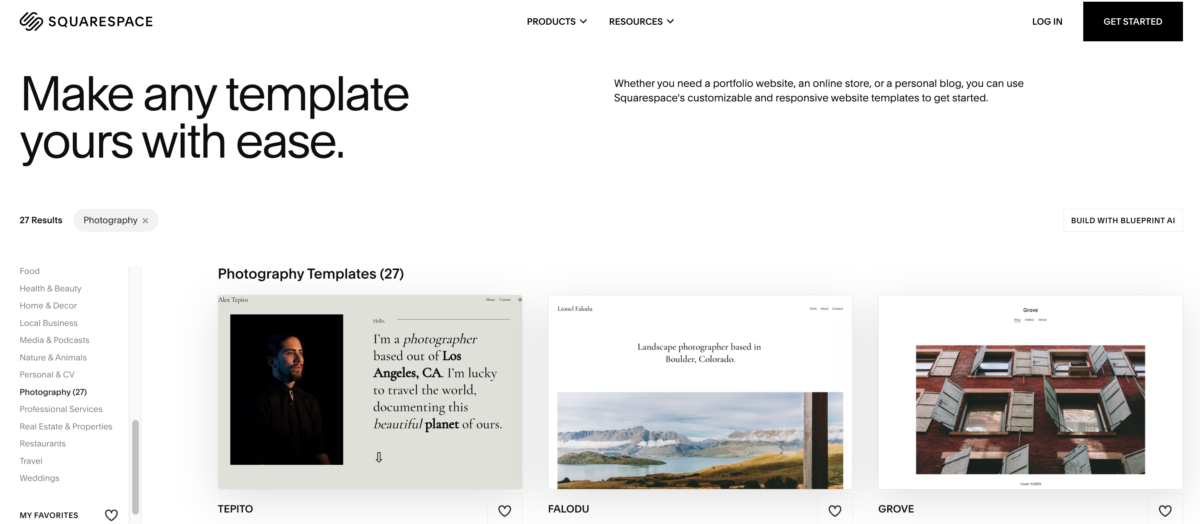
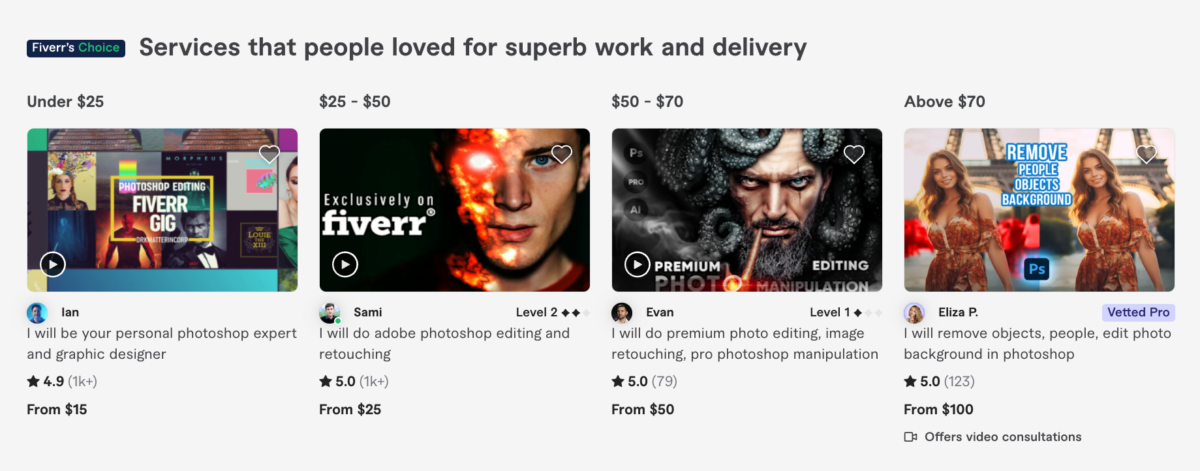

 Helpful resource: Of course, you’ll need to invest in a solid drone camera — we’ve put together
Helpful resource: Of course, you’ll need to invest in a solid drone camera — we’ve put together 
